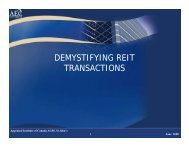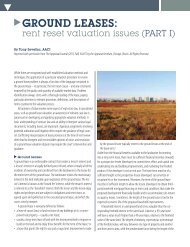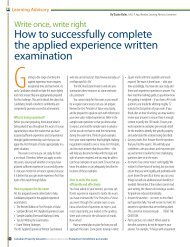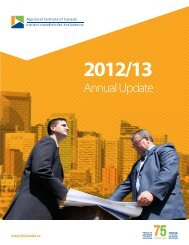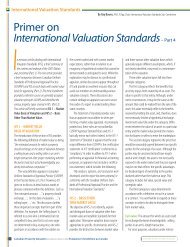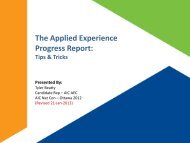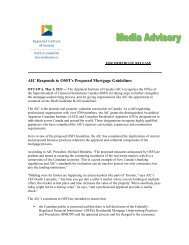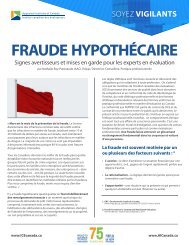Book 1 - Appraisal Institute of Canada
Book 1 - Appraisal Institute of Canada
Book 1 - Appraisal Institute of Canada
Create successful ePaper yourself
Turn your PDF publications into a flip-book with our unique Google optimized e-Paper software.
Member pr<strong>of</strong>ileResponding to arapidly changing marketplaceThe advent <strong>of</strong> <strong>Appraisal</strong> Management Companies (AMCs) is among the latest developments changing the marketplace in which today’s real estateappraisers must find a way to thrive. Over the years, the market for real property appraisal services has evolved with the introduction <strong>of</strong> newtechnologies including automated valuations and other risk assessment tools. Products such as mortgage and title insurance have reduced the needfor full appraisals. <strong>Appraisal</strong> management companies have flourished in <strong>Canada</strong> and in the United States. And then there is the economy – the downturn thatstarted in 2008 is still being felt coast to coast and it appears that recovery will be slow. The negative impact on AIC members has been significant.Kevin Fedynak, CRADave Cunningham, CRABarry Lebow, CRATake Kevin Fedynak, CRA, for example.Over the past 30 years, he built a trustedrelationship with the major banks. At onepoint, Halvorsen Fedynak & Company Inc.– <strong>of</strong> which Fedynak is a principal – receivedup to 150 requests per month for appraisalsin the Edmonton area from one majornational bank alone. Those days are goneand requests for appraisals have droppedsubstantially, primarily as a result <strong>of</strong> theeconomic slowdown. This has resulted in asignificant reduction in Halvorsen Fedynakstaff.This situation is certainly not unique toFedynak. In the Durham Region <strong>of</strong> Ontario,Dave Cunningham – a CRA since 1984– has also experienced a sharp reduction inhis mortgage appraisal work.Barry Lebow, CRA, has been in theappraisal pr<strong>of</strong>ession for more than 40 years.He has always seen his work in the world <strong>of</strong>Ontario real estate valuation as a business,first and foremost. “We lose clients all thetime because it is the natural course <strong>of</strong>business,” he notes. For instance, in the1990s, Lebow and his partners built a largeclientele among <strong>Canada</strong>’s trust companies.When most <strong>of</strong> the trust companiesdisappeared, the firm’s revenue declinedfrom $1.5 million to $475,000 in one year.“So I went out and found another client,” says Lebow, adding that hegradually built a relationship with a developer specializing in buying andselling apartment buildings. “You have to continually go out and reinventyourself.”Over the years, Lebow has diversified into everything from estatesettlements to litigation work, insurance replacement valuations, divorcesettlements and expert witness appearances. “There is so much morefor an appraiser to do and with higher fees than the mortgage business,”he explains. In fact, today, his firm does anything but mortgage work,something in which Lebow sees no significant revenue.Similarly, Cunningham is now <strong>of</strong> looking at other options andopportunities. He has already started to do some work in litigation,relocation and power sales, although, he admits, not in any great volume.His attention has also turned towards distressed and contaminatedproperties, an area that is developing into a niche market. “I am looking atopportunities where I might need to reeducate myself and retrain myselfto do certain types <strong>of</strong> work. There are opportunities out there. Some <strong>of</strong>them are related to work I already do and that I am looking to expand. As apr<strong>of</strong>essional, I do not feel I have the skill sets yet, so I have been looking tosee what courses are available from the AIC or through other sources.”Lebow sees ongoing education and pr<strong>of</strong>essional development asessential to maintaining an appraiser’s status as a pr<strong>of</strong>essional. Continuouseducation is also a key component to attaining the highest level <strong>of</strong> businesspractice. Lebow divides the development <strong>of</strong> a business into four levels: i)unknown, ii) commodity, iii) secret expert, and iv) go-to expert.He notes that, after surpassing the entry level point <strong>of</strong> being anunknown, many appraisers are content to remain at the commodity levelproviding a specified, if <strong>of</strong>ten highly honed, service for a fee. However, theproblem with the commodity level is its vulnerability to market supply anddemand, bidding wars and undervaluing <strong>of</strong> service.14Canadian Property Valuation Volume 54 | book 1 | 2010 Évaluation Immobilière au <strong>Canada</strong>click here to return to table <strong>of</strong> contents



